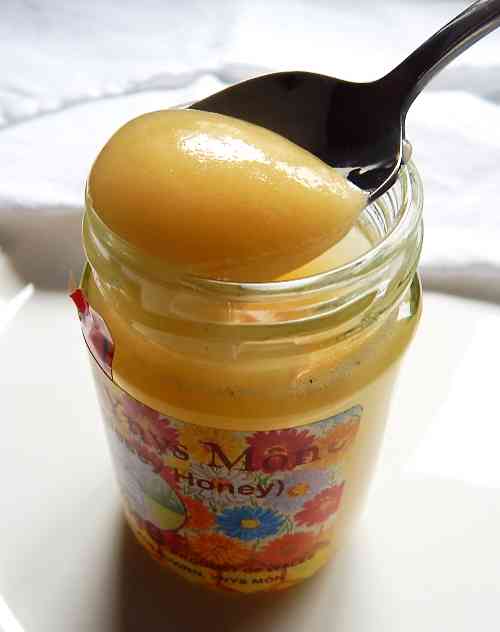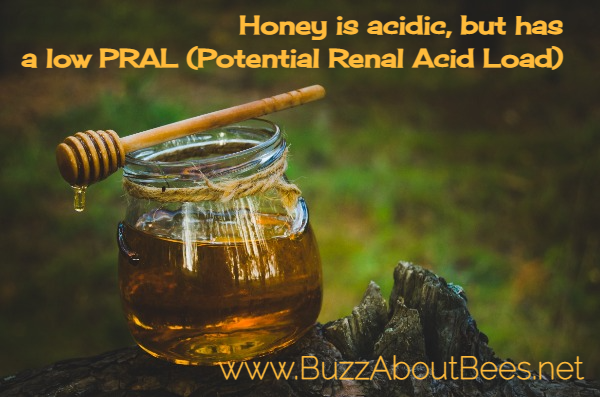Is Honey Acidic Or Alkaline?
Many people seeking to improve their health with nutrition and diet, have become concerned about the ratio of acidic or alkaline foods they consume.
So is honey acidic or alkaline?
Short Answer:
Yes, honey is acidic - that is, honey has an acidic pH that is at a level considered low enough to prevent growth of micro-organisms. For this reason, honey has sometimes been used as a natural anti-bacterial agent.
However, within the context of the human diet, honey has a low PRAL (Potential Renal Acid Load).
Explanation - How honey is measured as 'acidic'
The pH scale ranges from 0 to 14, where anything with a pH of less than 7 is considered acidic. A pH of 7 is neutral. A pH greater than 7 is considered alkaline.
Pure water has a neutral pH, however, the pH of water will change if any other substance or solution is added to it.
Scientists have recorded a pH level of between 3.3 to 6.5 for different types of honey, so honey is therefore acidic outside of the human body.
Is the acid level in honey safe for human stomachs?
 Honey, like many foods we commonly eat, is acidic.
Honey, like many foods we commonly eat, is acidic.Yes, certainly - as long as there are no other reasons why removing honey from your diet would be a good idea - for example, it's a good idea to refrain from eating honey if you are diabetic.
Although honey is acidic, it has a low Potential Renal Acid Load - more about this see below.
Elsewhere on my website, I compare the nutritional content of honey with other foods (such as agave nectar), so let's compare the pH of other foods we commonly consume:
| Food Item | pH Value |
|---|---|
| Bananas | 4.5 - 5.2 |
| Egg plant | 4.5 - 5.3 |
| Cauliflower | 5.6 |
| Pumpkin | 4.99 - 5.90 |
| Nectarines | 3.92 - 4.18 |
| Potatoes | 5.4 - 5.9 |
Is Honey Acidic Or Alkaline When Consumed?
Does Honey Increase Acid In The Body When Eaten?
Those following an alkaline diet are sometimes interested in whether honey promotes acidity when consumed.
I don't follow any particular diet and cannot make a comment about the merits or otherwise of the alkaline diet, but I decided to check against research with regard to honey specifically.
Here's a nice quote from a 2019 published paper:
"In general, foods rich in protein, such as meat, cheese, eggs, and others, increase the production of acid in the body, whereas fruit and vegetables increase alkalis.
The capacity of acid or base production of any food is called potential renal acid load (PRAL)."
- Osuna-Padilla et (2019)
The higher the PRAL score of foods, the more acid produced in the body.
Honey (which is low in protein) has a low PRAL score.
In fact, the PRAL score of honey is -0.3.
Below is a comparison of the PRAL scores of 5 foods for your interest:
FOOD
PRAL SCORE
Parmesan cheese
34.2
Turkey
9.9
Ice cream
0.8
Honey
-0.3
Tomato
-3.1
Source: Schwalfenberg GK (2012)
Which acids are present in honey?
Where do the acids in honey come from?
There are many acids found in honey, most of which fall into the category of organic acids or amino acids.
Organic acids in honey:
Organic acids contribute to the overall level of acidity in honey.
Although they make up only a tiny amount of the solid component of honey (0.5%) organic acids in honey are very important for:
- honey preservation
- taste
- aroma
- color.
Gluconic acid is the main organic acid in honey, representing 70–90% of the total (Bogdanov, 1997).
Organic acids are likely to come directly from nectar or honeydew (citric, malic and oxalic), but the vast majority of them are produced from nectar and honeydew sugars by the action of enzymes secreted by bees during ripening and storage.
Free Amino acids in honey:
Amino acids are the building blocks of proteins (think of the way in which bricks are the building blocks of a wall).
These proteins are important for all kinds of things, such as the structure of cells, which in turn are important for maintaining physical health - hence one of the reasons honey is also very important for bees!
Over 20 amino acids have been detected in honey, including:
|
|
The main source of amino acids is pollen.
What is the pH of different types of honey?
Here are some specific examples of pH for different types of honey compiled from research papers:
| Honey Type | pH | Research Source |
|---|---|---|
| Chestnut | 4.53 | Fernandes et al, 2020 |
| Eucalyptus | 3.82 - 4.4 | Fernandes et al, 2020; Bogdanov, 1997 |
| Orange blossom | 3.62 - 3.8 | Fernandes et al, 2020; Bogdanov, 1997 |
| Rosemary | 3.50 | Fernandes et al, 2020 |
| Heather | 4.32 | Fernandes et al, 2020 |
| Manuka | 4.32 | Fernandes et al, 2020 |
| Acacia | 3.9 | Bogdanov, 1997 |
| Blossom | 4.1 | Bogdanov, 1997 |
| Chestnut | 5.4 | Bogdanov, 1997 |
| Dandelion | 4.4 | Bogdanov, 1997 |
| Lavender | 3.4 | Bogdanov, 1997 |
| Rape | 3.9 | Bogdanov, 1997 |
| Rhododendron | 3.7 | Bogdanov, 1997 |
| Sunflower | 3.7 | Bogdanov, 1997 |
| Honeydew | 4.4 | Bogdanov, 1997 |
Does honey contain citric acid?
Yes, citric acid is one of the organic acids that may be found in honey.
More topics of interest:
References
A variety of papers and resources have been used to compile this information, including:
- De-Melo, Adriane & Almeida-Muradian, Ligia & Sancho, Maria & Pascual Maté, Ana. (2017). Composition and properties of Apis mellifera honey: A review. Journal of Apicultural Research. 1-33.
- Hermosin I, Chicon RM, Dolores Cabezudo M. Free amino acid composition and botanical origin of honey. Food Chem. 2003;83:263–268. doi: 10.1016/S0308-8146(03)00089-X.
- Kečkeš J, Trifković J, Andrić F, Jovetić M, Tešić Z, Milojković-Opsenica D; Amino acids profile of Serbian unifloral honeys. J Sci Food Agric. 2013 Oct; 93(13):3368-76.
- Chua L.S., Adnan N.A., 2014. Biochemical and nutritional components of selected honey samples. Acta Sci. Pol., Technol. Aliment. 13(2), 169-179.
- Şeyda Kıvrak (March 15th 2017). Analysis of Amino Acid and Phenolic Content in Honey by UPLC-ESI-MS/MS, Honey Analysis, Vagner de Alencar Arnaut de Toledo, IntechOpen, DOI: 10.5772/67317. Available from: https://www.intechopen.com/books/honey-analysis/analysis-of-amino-acid-and-phenolic-content-in-honey-by-uplc-esi-ms-ms
- Schwalfenberg GK. The alkaline diet: is there evidence that an alkaline pH diet benefits health? J Environ Public Health. 2012;2012:727630. doi: 10.1155/2012/727630. Epub 2011 Oct 12. PMID: 22013455; PMCID: PMC3195546.
- Bogdanov S; Nature and Origin of the Antibacterial Substances in Honey; Lebensm.-Wiss. u.-Technol., 30, 748–753 (1997).
- Osuna-Padilla IA, Leal-Escobar G, Garza-García CA, Rodríguez-Castellanos FE. Dietary Acid Load: mechanisms and evidence of its health repercussions. Nefrologia (Engl Ed). 2019 Jul-Aug;39(4):343-354. English, Spanish. doi: 10.1016/j.nefro.2018.10.005. Epub 2019 Feb 5. PMID: 30737117.
- Dressman JB, Berardi RR, Dermentzoglou LC, Russell TL, Schmaltz SP, Barnett JL, et al. Upper gastrointestinal (GI) ph in young, healthy men and women. Pharm. Res. 1990; 7: 756–761.
- Russell TA., Berardi RR., Barnett JL, Dermentzoglou LC, Jarvenpaa KM., Schmaltz SP, et al. Upper gastrointestinal pH in seventy-nine healthy, elderly, North American men and women. Pharm Res. 1993; 10: 187–196.
- Sohaimya et al; Physicochemical characteristics of honey from different origins; Annals of Agricultural Sciences Volume 60, Issue 2, December 2015, Pages 279-287.
- Fernandesa et al; Portuguese honeys as antimicrobial agents against Candida species; Journal of Traditional and Complementary Medicine; February 2020.
- pH Values of Common Foods and Ingredients; https://www.clemson.edu/extension/food/
food2market/documents/ph_of_common_foods.pdf
If you found this page helpful or interesting, I'd really be grateful if you would share it with others - if not this page, perhaps another, such as Gardening For Bees.
Thank you so much :) .
